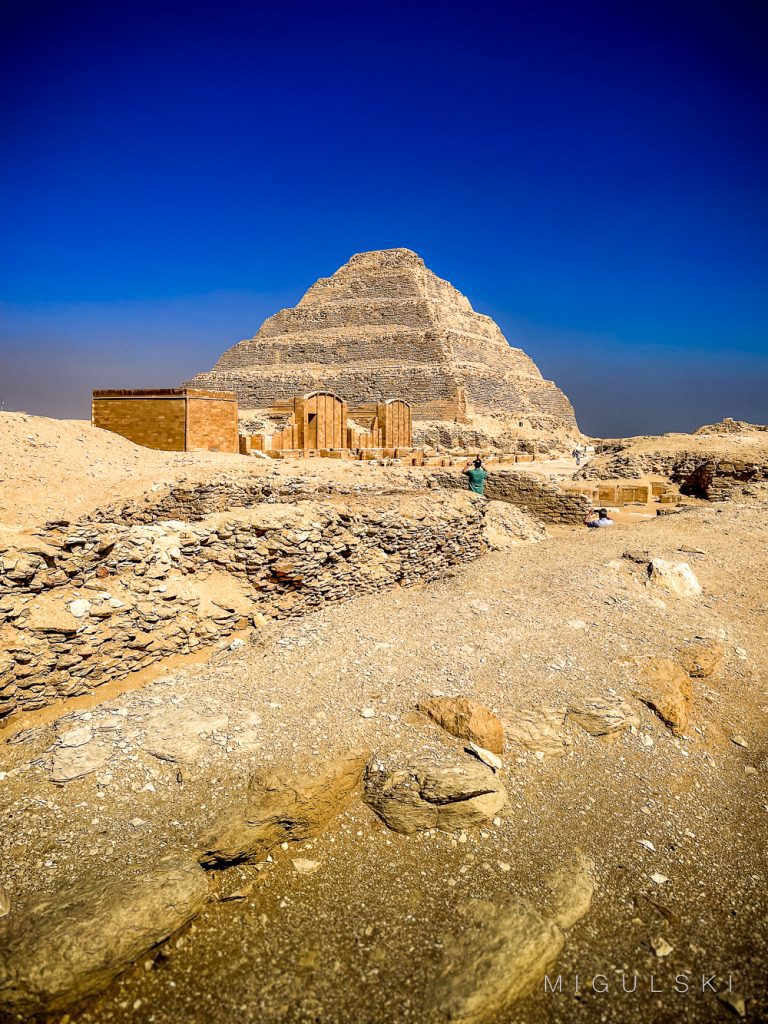
Nestled on the Saqqara plateau, an ancient burial ground that echoes with the whispers of millennia, the Step Pyramid of Djoser stands as a testament to the ingenuity and vision of the ancient Egyptians. Built during the 27th century BCE for Pharaoh Djoser, this architectural marvel is not merely a tomb but a groundbreaking structure that marked the evolution of pyramid construction. This article delves into the rich history, architectural significance, and cultural context surrounding the Step Pyramid of Djoser, illuminating the mysteries that shroud this ancient wonder.
A Royal Vision Unveiled: Pharaoh Djoser’s Ambitious Undertaking
The Step Pyramid of Djoser, also known as the Pyramid of Djoser or the Step Tomb, was commissioned by Pharaoh Djoser, the second king of the Third Dynasty of Egypt. Imhotep, a polymath of remarkable skill and wisdom, served as the chief architect of this monumental project. Imhotep’s innovative approach departed from the traditional mastaba-style tombs, leading to the creation of the world’s first pyramid.
The construction of the Step Pyramid marked a significant departure from the previous burial practices of the Old Kingdom. Instead of the conventional mastaba, Djoser envisioned a grand structure that would not only serve as his final resting place but also symbolize his eternal reign and divine connection.
Architectural Ingenuity: The Evolution from Mastaba to Pyramid
Imhotep’s revolutionary design transformed the Step Pyramid into a six-tiered structure, creating a step-like structure that ascended toward the heavens. The initial structure, often referred to as the Pyramid of Djoser’s Pyramid, comprised six mastaba-like layers stacked on top of one another. These steps, gradually decreasing in size as they ascended, formed a pyramid that would become an archetype for the monumental pyramids that followed.
Each level of the Step Pyramid was constructed with finely cut limestone blocks, creating a smooth and imposing façade. The use of limestone, rather than the traditional mudbrick, contributed to the pyramid’s durability and enduring presence in the archaeological landscape. The entire complex was enclosed by a high wall, further emphasizing its sacred and regal nature.
The Subterranean Labyrinth: Djoser’s Burial Ground and Mortuary Complex
Beneath the Step Pyramid lies a complex subterranean network that serves as the final resting place for Pharaoh Djoser. The burial chamber, accessed through a maze of corridors and tunnels, is a testament to the intricate planning and engineering prowess of Imhotep.
The underground labyrinth includes a central burial chamber containing Djoser’s sarcophagus, surrounded by smaller chambers believed to house symbolic offerings and artifacts for the afterlife. The intricate design of the subterranean complex reflects the ancient Egyptian belief in the continuity of life after death and the importance of a grand burial site for ensuring a smooth transition to the afterlife.
The South Tomb: A Satellite Pyramid and Enigmatic Structures
Adjacent to the Step Pyramid is the South Tomb, a smaller pyramid structure often referred to as a satellite pyramid. While its exact purpose remains a subject of scholarly debate, the South Tomb is thought to have held ritualistic significance in the funerary practices of the time.
The Step Pyramid complex also features other enigmatic structures, including the T-shaped corridor known as the Southern Tomb. These structures, often associated with various rituals and ceremonies, contribute to the mystique surrounding the Step Pyramid and its purpose beyond being a mere burial site.
Cultural and Religious Context: The Step Pyramid as a Symbol of Divine Kingship
The Step Pyramid of Djoser carries profound cultural and religious significance, transcending its role as a monumental tomb. In ancient Egyptian society, the pharaoh was not merely a mortal ruler but a divine figure believed to possess a direct connection to the gods. The construction of grand funerary monuments, such as the Step Pyramid, was a manifestation of the pharaoh’s divine status and a means to secure a harmonious transition to the afterlife.
The pyramid’s step-like structure, reminiscent of a stairway to the heavens, symbolized the pharaoh’s ascension to the divine realm. The pyramid’s towering presence on the Saqqara plateau underscored the grandeur of the pharaoh’s reign and the perpetuity of his divine authority.
Restoration and Conservation Efforts: Preserving an Ancient Legacy
Over the centuries, the Step Pyramid of Djoser faced the ravages of time, including natural elements and human activities. In recent years, extensive restoration and conservation efforts have been undertaken to safeguard this archaeological treasure for future generations.
The Step Pyramid Restoration Project, initiated by the Egyptian Ministry of Antiquities, focuses on stabilizing the structure, reinforcing weakened sections, and addressing the impact of environmental factors. Modern technologies, including 3D scanning and documentation, aid in the meticulous restoration process, ensuring that the Step Pyramid retains its majestic allure while withstanding the test of time.
Visitor Experience: Journeying into Egypt’s Ancient Past
For modern-day enthusiasts of history and architecture, a visit to the Step Pyramid of Djoser offers a mesmerizing journey into Egypt’s ancient past. The sprawling archaeological site, surrounded by the vastness of the Saqqara plateau, beckons visitors to explore the intricacies of ancient Egyptian civilization.
Guided tours provide insights into the historical context, architectural significance, and cultural implications of the Step Pyramid. Visitors can traverse the labyrinthine corridors, stand in awe of the towering structure, and contemplate the spiritual and symbolic dimensions that characterize this ancient wonder.
Conclusion: The Enduring Legacy of Djoser’s Pyramid
The Step Pyramid of Djoser, with its innovative design, architectural grandeur, and cultural symbolism, continues to captivate the imagination of those who venture into the realm of ancient Egypt. As a testament to the collaborative brilliance of Pharaoh Djoser and Chief Architect Imhotep, the pyramid stands not only as a burial site but as a beacon of human achievement.
Beyond its historical and archaeological significance, the Step Pyramid invites contemplation of the profound cultural and religious beliefs that shaped ancient Egyptian society. As ongoing restoration efforts ensure its preservation, the Step Pyramid remains an enduring testament to the timeless quest for immortality and the divine aspirations of a civilization that echoes through the ages.





